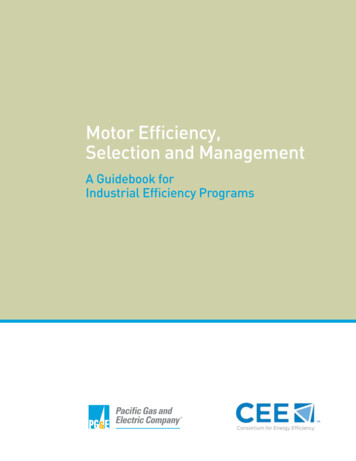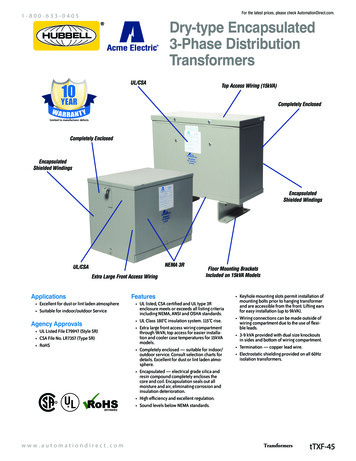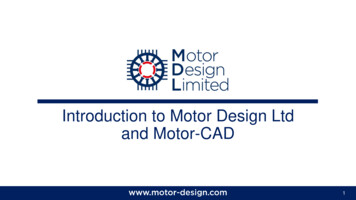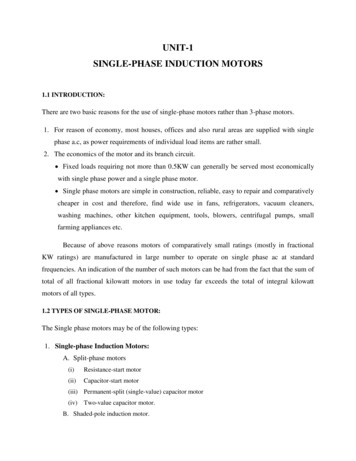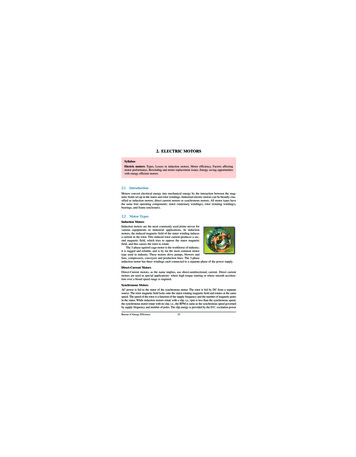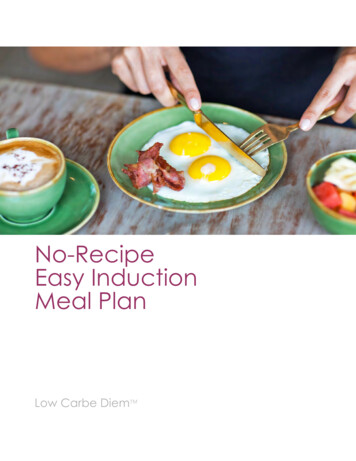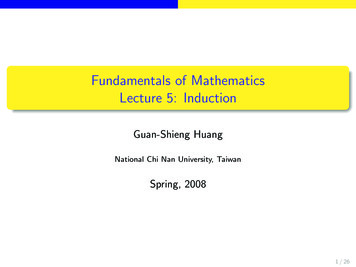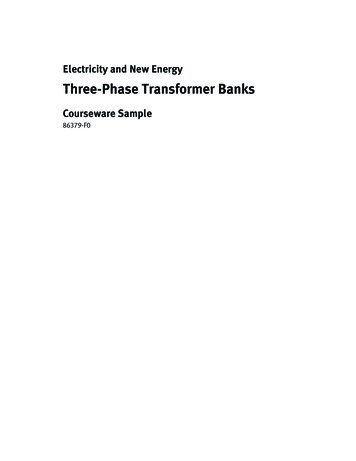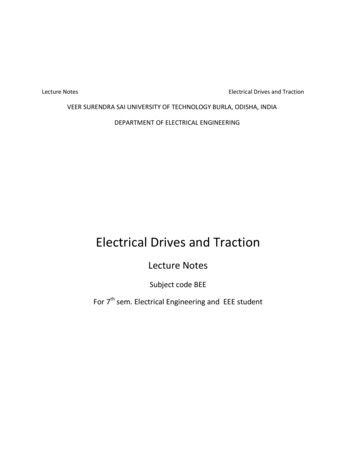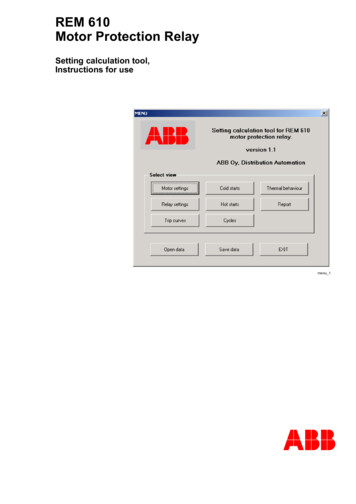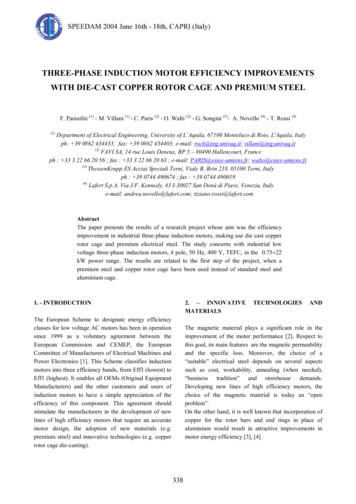
Transcription
SPEEDAM 2004 June 16th - 18th, CAPRI (Italy)THREE-PHASE INDUCTION MOTOR EFFICIENCY IMPROVEMENTSWITH DIE-CAST COPPER ROTOR CAGE AND PREMIUM STEELF. Parasiliti (1) - M. Villani (1) - C. Paris (2) - O. Walti (2) - G. Songini (3)- A. Novello (4) - T. Rossi (4)(1)Department of Electrical Engineering, University of L’Aquila, 67100 Monteluco di Roio, L'Aquila, Italyph: 39 0862 434433; fax: 39 0862 434403; e-mail: rock@ing.univaq.it; villani@ing.univaq.it(2)FAVI SA, 14 rue Louis Deneux, BP 5 – 80490 Hallencourt, Franceph : 33 3 22 66 20 56 ; fax : 33 3 22 66 20 63 ; e-mail: PARIS@esiee-amiens.fr; walto@esiee-amiens.fr(3)ThyssenKrupp ES Acciai Speciali Terni, Viale B. Brin 218, 05100 Terni, Italyph : 39 0744 490674 ; fax : 39 0744 490019(4)Lafert S.p.A. Via J.F. Kennedy, 43 I-30027 San Donà di Piave, Venezia, Italye-mail: andrea.novello@lafert.com; tiziano.rossi@lafert.comAbstractThe paper presents the results of a research project whose aim was the efficiencyimprovement in industrial three-phase induction motors, making use die cast copperrotor cage and premium electrical steel. The study concerns with industrial lowvoltage three-phase induction motors, 4 pole, 50 Hz, 400 V, TEFC, in the 0.75 22kW power range. The results are related to the first step of the project, when apremium steel and copper rotor cage have been used instead of standard steel andaluminium cage.2. – INNOVATIVEMATERIALS1. - INTRODUCTIONThe European Scheme to designate energy efficiencyclasses for low voltage AC motors has been in operationsince 1999 as a voluntary agreement between theEuropean Commission and CEMEP, the EuropeanCommittee of Manufacturers of Electrical Machines andPower Electronics [1]. This Scheme classifies inductionmotors into three efficiency bands, from Eff3 (lowest) toEff1 (highest). It enables all OEMs (Original EquipmentManufacturers) and the other customers and users ofinduction motors to have a simple appreciation of theefficiency of this component. This agreement shouldstimulate the manufacturers in the development of newlines of high efficiency motors that require an accuratemotor design, the adoption of new materials (e.g.premium steel) and innovative technologies (e.g. copperrotor cage die-casting).TECHNOLOGIESANDThe magnetic material plays a significant role in theimprovement of the motor performance [2]. Respect tothis goal, its main features are the magnetic permeabilityand the specific loss. Moreover, the choice of a“suitable” electrical steel depends on several aspectssuch as cost, workability, annealing (when needed),“business tradition” and storehouse demands.Developing new lines of high efficiency motors, thechoice of the magnetic material is today an “openproblem”.On the other hand, it is well known that incorporation ofcopper for the rotor bars and end rings in place ofaluminium would result in attractive improvements inmotor energy efficiency [3], [4].338
SPEEDAM 2004 June 16th - 18th, CAPRI (Italy)for electromechanical applications. Acciai SpecialiTerni has provided several electrical steels that havebeen used in the new prototypes; LAFERT S.p.A., one of the most important Italianmanufacturer of induction motors. LAFERT hasprovided the stator and rotor cores and statorwindings and has assembled the prototypes withcopper rotor cages; FAVI (Fonderie et Atelier du Vlmeu), Frenchcompany specialized in copper alloy pressure diecasting. FAVI has co-operated manufacturing a lineof high-temperature moulds and several copper rotorcages.The aim of the project is the analysis and theconstruction of several prototypes of induction motorsby using the above mentioned innovative technologicalsolutions, in order:- to define the design procedures and designstrategies;- to verify the actual efficiency improvements;- to verify the arrangement of the motors respect tothe European Classification Scheme (EC/CEMEP).The analysis concerns with industrial low voltage threephase induction motors, 4 pole, 50 Hz, 400 V, TEFC, inthe 0.75 22 kW power range.The proposed research program has been subdivided infour steps, according to the design strategies used tostudy and made higher efficiency motors.The cheapest strategy uses existing designs and toolingto produce more efficient motors and concerns the use ofimproved magnetic materials (“premium steel”) andcopper rotor cage: in this case the stator and rotor slotsdimensions and the inner and outside stator diameter areunchanged.The second strategy concerns the change of the stacklength and the stator winding. More expensive strategyforesees also the change of lamination (stator and rotorslots dimensions) and this requires a renewal of thelamination tooling even if the inner and outside statordiameters are unchanged. The most expensive designstrategy requires to change all motor dimensions, innerand outer stator diameters included. In this case a finaloption is the use of a larger frame size with modificationof the existing housing and maintaining the shaft height.The paper presents the results related to the first step ofthe project, when “premium steel” and copper rotor cageDie casting is widely recognized as a low cost rotor cagemanufacturing process. For these reason, die-castinghas become the fabrication method of choice andaluminium the conductor of choice in all but the largestframe motors. High-pressure die-casting of aluminiumsquirrel-cage rotors is a mature process performed bymost of motor manufacturers. The melting point foraluminium alloys is in the 670 C range and the materialused for the rotor’s die-casting mould is not highlystressed at these temperatures. Die life can be in thehundreds of thousands of rotors depending on diecomplexity.The most commonly used method to manufacture rotorswith copper conductors is referred to as “weldedassembly construction”. Such fabrication involvesintensive hand labour and therefore is expensive [5], [6].Up today, only small numbers of very large motorsutilize copper in the rotors by this mechanicalfabrication.Copper die-cast rotor construction does not differsignificantly from the aluminium one and, in essence, themanufacturing details are identical. The additionalmanufacturing challenges are increased temperatures andpressures required to die-cast copper: it melts at 1083 C.Although copper die-cast rotor construction is a muchnewer technology, current state of the art technologymakes it possible to die cast similarly sized rotors incopper as can be cast in aluminium. The integrity andreliability of copper die-cast is just as good as inaluminium die-cast. The primary reason copper die-castrotors are not commonplace yet is because it requiresspecialized equipment (investment) and know-how inthis field.3. – HIGH EFFFICIECY MOTOR RESEARCHThe authors have deeply investigated the use of copperrotor cage in combination of high quality electricalsteels.This activity falls in a research program partiallysupported by the Italian Ministry of Education,University and Research.Together with the University of L’Aquila, threeimportant Companies have been involved in the project: ThyssenKrupp ES Acciai Speciali Terni, Italy,European leader in the production of electrical steels339
SPEEDAM 2004 June 16th - 18th, CAPRI (Italy)have been used instead of standard steel and aluminiumcage.2500µp (1.5 T)20008050H4. – DEVELOPMENT OF THE PROJECT1500Three power sizes have been considered in the range0.75 22 kW: 3, 7.5 and 15 kW, 4 pole, 50 Hz, 400 V,TEFC, single-cage rotor. The minimum nominalefficiencies for these motors according to theEC/CEMEP standard are show in Table 1.Table 1- EC/CEMEP minimum efficiency standards23546W/kg (1.5 T)Eff1382.687.47.587.090.11589.491.8B (T)Eff23150Fig. 1 - Permeability and loss at 1.5 T of the considered steelsfor 4-pole motorskW5350100050080505350H21.81.6Three standard motors have been chosen as “referencemotors”: they are commercial motors with aluminiumrotor cage and standard electrical steel; two motors (3and 7.5 kW) belong to the low efficiency class Eff3, thethird (15 kW) is in the Eff2 class .1.41.215350H80500.80.64.1 – Choice of the electrical steel0.4210First of all, the most suitable electrical steel has beenchosen. This choice has been done with reference to thematerial performance (loss/permeability) and hardness(HRB).The standard electrical steel used in the reference motorsconstruction is labelled 8050.The following alternative electrical steels have beenconsidered:- low loss electrical steels: 5350 and 3150;- high permeability electrical steels: 8050H, 5350H.Their main characteristics are summarized in Fig. 1.The influence of electrical steels and copper rotor cageon motor performance have been evaluated bysimulations. The results have been compared withcommercial motor ones in order to evaluate theachievable improvement due to the use of “premiumsteels” and copper cage only without affecting the designof standard motors.310H (A/m)410Fig. 2 – B-H curves of 8050 and 5350HOn the base of these preliminary analyses and thematerial hardness, the high permeability steel 5350H hasbeen chosen. Electrical steel 5350H represents a verygood compromise between specific loss andpermeability. In fact, frequently better magneticmaterials from the losses point of view have worsepermeability (in Fig. 1 see electrical steels 3150 and5350 in comparison with 8050). As a consequence, theincreases of magnetizing current and correspondingJoule losses reduce the benefit of lower iron losses.Actually, the electrical steel 5350H can be define“premium steel” because combines low specific losses(3.5 W/kg respect to 5.5 of the 8050) with highpermeability (better than 8050 under 1.2 T, a little bitworse over, Fig. 2).340
SPEEDAM 2004 June 16th - 18th, CAPRI (Italy)4.2 –Tested motors5. – MOTOR PERFORMANCE TEST RESULTSThe results of this preliminary analysis have allowed tostart the next step concerning the construction of theprototypes according to the following combinations, foreach power size:a) standard steel 8050 and aluminium cage(“reference” commercial motor);b) standard steel 8050 and copper cage;c) premium steel 5350H and copper cage.Comparisons between motors a) and b) allow to evaluatethe improvements achievable with copper rotors only.Motors c) results show the effects of the premium steelrespect to the standard steel (in comparison with motorsb) and the improvements respect to the standard motor(in comparison with motors a)).In order to obtain an accurate comparison betweenmotors a) and b), the same wound stator with electricalsteel 8050 was used for each size to test motors a) andb). Table 2 presents the main dimensions and weightsof the tested motors (reference motors and newprototypes) while Fig. 3 shows a view of the copperrotors.5.1 – Standard test methodsWorldwide, there exist several standards for testingelectric machinery. For induction motors, the three mostimportant ones are: IEEE Standard 112, currently in use in USA andsome parts of the world; JEC 37, in Japan; IEC 34-2, in use in most European countries.In Canada, the Standard specified in the EnergyEfficiency Regulations is : “Method for determiningenergy performance of three-phase induction motors”CSA C390-98. This Standard is equivalent to the wellrecognized Standard IEEE 112-1996, Method B: “TestProcedure for Polyphase Induction Motors andGenerators”. IEEE and CSA methods are true input vsoutput power efficiency tests that segregate losses intofive categories: Iron Losses, Stator Resistance, RotorResistance, Friction and Windage (F&W) and StrayLoad Losses (SLL). The first four are measured directlyand the remainder is the “stray load” category.In order to evaluate the copper rotor and premium steeleffects on each loss category, a loss segregation methodis required. Then, the experimental results presented inthe paper refer to the Standard CSA C390-98.Table 2 - Tested motors main dimensions and weights3 kW7.5 kW15 kW(mm)130160220Outer stator diameter (mm)152200250Stack lengthInner stator diameter90127160Stator winding weight (kg)Rotor cage .8Gross iron22.447.8103(kg)5. 2 - Test resultsTable 3 shows the CSA test results of the 3 kW testedmotors.The substitution of copper for aluminium directlyachieved 75% of the total savings in rotor losses and wasindirectly involved in saving the other 25% in statorresistance losses. Rotor I2R losses were reduced by 46%and the efficiency resulted 2.1 percentage points higher;as expected, iron and F&W losses were constant.Premium steel as magnetic material was involved ingaining about half point in efficiency. Saving in ironlosses is partially compensated by the stator windinglosses increasing, as a consequence of the magnetizingcurrent increasing.In case of 3 kW motor, copper rotor and premium steeladoptions have allowed to move motors in the Eff2 class.Table 4 shows the other motors main performance.Fig. 3 – View of copper rotors for the considered motors341
SPEEDAM 2004 June 16th - 18th, CAPRI (Italy)Stator winding temperature rise TSW was reduced by4 C with copper cage and by 16 C with premium steeland copper cage compared with the commercial motor.That is a very important feature because temperature riseis significant in the life expectancy of the motor.24 C with premium steel compared with the commercialmotor. Lower temperatures mean that smaller coolingfans can be used and this has a significant effect inreducing the friction and windage losses on these motorswith copper rotors and premium steel.The efficiency improvements were 3.2 and 3.9 pointsrespectively. Nevertheless, the motors do not move inthe Eff1 class, stopping in Eff2.Table 3 – CSA C390-98 Efficiency and Loss Segregation TestResults. 3 kW motor.3 kWη%Σlosses (W)Stator wind.Rotor cageIronSLLF&WAl 8050Cu 8050Cu 53378394823Table 5 – CSA C390-98 Efficiency and Loss Segregation TestResults. 7.5 kW motor.7.5 kWI(A) TSW ( C)Power FactorSlip %TB(Nm)TL(Nm)Al 8050Cu 8050Cu 10.752.76242.8Cu 8050Cu 5350H84.287.488.1Σlosses (W)140110771035Stator wind.Rotor 8848ηTable 4 – 3 kW motors performance3 kWAl 8050%Table 6 – 7.5 kW motors performance7.5 kWI(A) TSW ( C)Power FactorSlip %TB(Nm)TL(Nm)Power factor was constant while slip was significantlylower for both copper motors. In fact, due to thedifference in conductivity between the two materials,copper motor generates a higher torque at same slip thanthe aluminium motor one: copper motor does not slowdown much under load. This implies a very goodresponse on variable frequency drives, but potentialproblems on variable torque loads like fans and pumps.Copper motors exhibited substantially constantbreakdown torque TB ( 8%) but a significant drop inthe locked rotor torque TL (- 18%), due the rotorlaminations designed for aluminium. However, withfurther design adjustments (redesign of the stator androtor laminations to take advantage of the increasedconductivity of copper rotor bars) these negative torquefactors could be corrected [3].Tests of 7.5 kW motors (Table 5 and Table 6) confirmwhat found for the smaller motors. Rotor losses were50% lower in the copper rotors and the overall losseswere reduced by 23% and 26% (in case of copper rotorand premium steel adoption). Stator winding temperaturerise TSW was reduced by 18 C with copper cage and byAl 8050Cu 8050Cu .821.79108Table 7 – CSA C390-98 Efficiency and Loss Segregation TestResults. 15 kW motor.15 kWAl 8050Cu 8050Cu 5350H90.191.091.9Σlosses (W)163414731316Stator wind.Rotor 721991η%Table 8 – 15 kW motors performance15 kWI(A) TSW ( C)Power FactorSlip%342Al 8050Cu 8050Cu 5350H28.3620.842.4728.3580.831.528.6580.811.31
SPEEDAM 2004 June 16th - 18th, CAPRI (Italy)Tab. 7 and Tab. 8 show the 15 kW motors test results. Inthis case copper rotors yielded an average 44% reductionin measured rotor losses while the overall losses werereduced by 10%. With premium steel and copper rotor,iron losses were reduced by 24% and the overall lossesby 20% and 11% respect to the standard motor and thecopper motor. In comparison with standard motor, theefficiency improvements were 0.9 points with copperrotor and 1.8 points with premium steel and copper rotor.For the 15 kW copper motor, it is interesting to remarkthat the tolerance on the efficiency could classify thismotor as Eff1. With the adoption of premium steel andcopper rotor, the 15 kW motor is fully in Eff1 class.The substitution of copper for aluminium has allowed tomove the 3 and 7.5 kW motors in the Eff2 class. Theefficiency improvements are not uniform for all the sizesand vary from 0.9 points for the 15 kW to 3.2 points forthe 7.5 kW. For the 15 kW it is interesting to remark thatthe tolerance on the new efficiency could classify thismotor like as Eff1.The use of 5350H electrical steel (premium steel)improves efficiencies of 0.4, 0.7 and 0.9 points fromsmaller to larger motors. However, premium steel andcopper rotor do not give rise any further movement(from Eff2) for the 3 kW and 7.5 kW, while the 15 kWreaches the Eff1 class (without tolerance).5. 3 – Comparison with literature data7. – REFERENCESTable 9 summarises the overall motor efficiencies androtor losses reductions experimentally observed inmotors fitted with copper rotors where comparisons withaluminium are reported in literature including the data ofthis study. The range 3 18.8 kW, 4 poles motors iscovered. The rotor loss reduction is in the range40 50%. The efficiency gain is between 1 and 3 points.[1] Bertoldi, P.; Kuehnemund, G.: The EuropeanNegotiated Agreement to Improve Motor Efficiency.“Energy Efficiency Improvements in Electric Motorsand Drives”, Editors: P. Bertoldi, A. de Almeida, H.Falkner, Springer, 2000, pp. 369-375, ISBN: 3-54067489-6.[2] Parasiliti F.; Villani M.: Technical and economicalevaluation of electrical steels for high efficiency motors.Transworld Research Network, Recent Res. Devel.Magnetics, n. 2, 2001, ISBN: 81-7895-001-4.[3] Parasiliti F.; Villani M.: Design of high efficiencyinduction motors with die-casting copper rotors.“Energy Efficiency in Motor Driven Systems”, Editors:F. Parasiliti, P. Bertoldi, Springer, 2003, pp 144-151,ISBN 3-540-00666-4.[4] Brush E.F.; Cowie, J.G.; Peters D.T.; Van SonD.J.: Die-Cast Copper Motor Rotors: Motor TestResults, Copper Compared to Aluminum. “EnergyEfficiency in Motor Driven Systems”, Editors: F.Parasiliti, P. Bertoldi, Springer, 2003, pp. 136 –143,ISBN 3-540-00666-4.[5] Finley, W.R.; Hodowanec, M.M.: Selection ofCopper versus Aluminum Rotors for Induction Motors.IEEE Transactions on Industry Applications, Vol. 37, n.6, November/December 2001, pp. 1563 – 1573.[6] Paris, C; Walti, O.: A New Technology to MakeRotors with Copper as Magnetic Conductor. “EnergyEfficiency in Motor Driven Systems”, Editors: F.Parasiliti, P. Bertoldi, Springer, 2003, pp. 152 – 161,ISBN 3-540-00666-4.Table 9 - Overall motor efficiencies and rotor loss reductionsvia copper rotors. Data from this study and the 2.5Diff.Rotor LossReferenceReduction %3.22.13.21.20.91.65846504044404This studyThis study4This study46. – CONCLUSIONSThe paper presented test results concerning severalprototypes of induction motors with die-cast copper rotorcages and premium electrical steel with the aim to verifythe actual efficiency improvements and the arrangementof the motors respect to the European ClassificationScheme EC/CEMEP. Three standard motors have beenchosen as “reference motors”: two motors (3 and 7.5kW) belong to the low efficiency class Eff3, the third (15kW) is in the Eff2 class.343
THREE-PHASE INDUCTION MOTOR EFFICIENCY IMPROVEMENTS WITH DIE-CAST COPPER ROTOR CAGE AND PREMIUM STEEL F. Parasiliti (1) - M. Villani (1) - C. Paris (2) - O. Walti (2) - G. Songini (3)- A. Novello (4) - T. Rossi (1) Department of Electrical Engineering, University of L'Aquila, 67100 Monteluco di Roio, L'Aquila, Italy ph: 39 0862 434433; fax: 39 0862 434403; e-mail: rock@ing.univaq.it .
